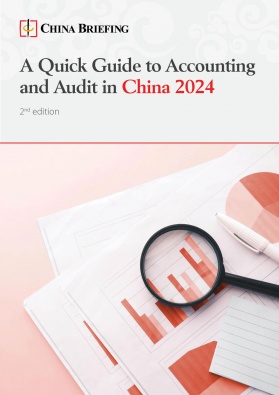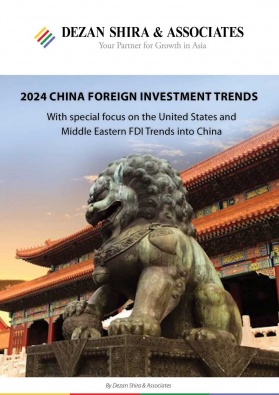China’s 2024 Catalogue for Guiding Industry Restructuring
The 2024 Catalogue for Guiding Industry Restructuring, announced by China’s NDRC, marks a strategic shift by focusing on high-tech industries and environmental priorities. Businesses are urged to grasp the dual emphasis, align with evolving policies, and capitalize on emerging opportunities in the dynamic economic landscape.
On December 29, 2023, China’s National Development and Reform Commission (NDRC) revealed the upcoming 2024 Edition of the Catalogue for Guiding Industry Restructuring (referred to as the “Catalogue”). This unveiling followed the seeking opinion on the Exposure Draft until August 14, 2023.
Set to come into effect on February 1, 2024, the Catalogue will formally supersede the 2019 version.
This updated edition serves as a comprehensive guide, intricately charting the strategic roadmap for the restructuring of diverse industrial sectors across China. It also signifies a step towards aligning industries with evolving economic goals and priorities.
This Catalogue carries substantial guidance for both domestic and foreign investors, offering insights into sectors that are promoted or discouraged for investment. In this article, we present an overview of the Catalogue’s key contents, along with the updates featured in the 2024 version.
What is the Catalogue for Guiding Industry Restructuring?
The Catalogue for Guiding Industry Restructuring is a governmental document that provides guidance and direction for the restructuring of industries. It serves as an important reference for directing social investments, managing government investment projects, and formulating policies related to finance, taxation, credit, land, imports, and exports.
The Catalogue classifies industries into three categories – “encouraged,” “restricted,” and “obsolete”. It essentially filters out elements that align with national laws and policies. Specifically:
- The “encouraged” category involves advanced technologies, equipment, products, and industries crucial for fostering high-quality economic and social development and emphasizes the need for active support and promotion. Projects falling under the “encouraged” category may be eligible for support in the form of fiscal, tax, land, and credit assistance, potentially provided by government departments and financial institutions.
- The “restricted” category pertains to outdated technologies, equipment, and products that diverge from industry access conditions and relevant regulations. For projects falling under the restricted category, new construction projects are prohibited. Existing production capacities are allowed to undergo transformation and upgrades within a specified timeframe.
- The “obsolete” category encompasses obsolete technologies, equipment, and products failing to adhere to relevant laws and regulations, signifying a lack of safe production conditions, substantial resource wastage, and environmental pollution. Investment in projects classified as obsolete is strictly prohibited, and they must be phased out according to the stipulated timeframe.
What is the background of the 2024 Catalogue?
Since its inception in 2005, the Catalogue for Guiding Industry Restructuring has been a pivotal instrument in shaping investments and directing government projects in China.
Previously updated in 2011, 2013, and 2019, this critical policy document has continuously evolved to keep pace with dynamic market challenges and demands.
The 2024 edition serves as the latest chapter in this ongoing evolution. It plays a vital role in influencing China’s economic landscape, reflecting the commitment of the NDRC and collaborating departments to adapt and fine-tune strategies for the ever-changing market conditions. This revision aims to align the Catalogue with the latest market dynamics and emerging economic priorities.
What’s new in the 2024 Catalogue?
The 2024 Catalogue consists of a comprehensive set of 1005 entries, categorized into 352 entries under the Encouraged category, 231 entries under the Restricted category, and 422 entries under the Obsolete category.
A comparative analysis with the previous 2019 version reveals a notable decrease of 473 entries in total – a significant reduction of 469 entries in the Encouraged category, a modest increase of 16 entries in the Restricted category, and a decrease of 20 entries in the Obsolete category. The decline in the number of entries within the Encouraged category primarily stems from a strategic consolidation and integration approach regarding industry categories, aimed at unifying entries that share similar characteristics or objectives. This strategic move aims to simplify and enhance the effectiveness of the Catalogue, grouping priority investment areas for easier comprehension.
The policy changes of the 2024 Catalogue also include:
- Inclusion of high-tech industries: The 2024 version of the Catalogue demonstrates a heightened focus on advancing technology, with various high-tech sectors now falling under the “encouraged industry” category. New additions include smart manufacturing, advanced agricultural machinery, and machine automation, indicating a concerted effort to foster innovation and technological advancement.
- Increasing focus of the green economy: The 2024 Catalogue exhibits a significant emphasis on sustainability, with the term “green” appearing more than 50 times. This expanded focus not only continues to emphasize the crucial role of the green economy in traditional manufacturing industries but also actively encourages market entities to explore and invest in various green sectors, including agriculture, fisheries, energy, pharmaceuticals, transportation, recycling, and in particular, green tech (such as novel energy storage technologies, green hydrogen carbon capture, utilization, and storage, and next-generation perovskite solar cells.This shift highlights the Chinese government’s push to encourage industries to enhance their environmental, social, and governance (ESG) performance and recycling capabilities. ). It also demonstrates China’s ambition to take a lead in the global energy transition and underpins the country’s plan to transition its economy to a greener and higher value-added one.
- Development of modern service industries: The 2024 Catalogue also puts extra emphasis on the integration of modern service industries, such as advanced manufacturing and modern agriculture, and hopes to facilitate new forms, models, and paths of business. Among others, China wants to promote the extension of producer services to achieve specialization and move upwards to the higher end of the value chain. This would entail accelerated development of research and development, design, modern logistics, legal services, and other services, besides further digitization of services. In addition, amid China’s demographic shifts and the Common Prosperity drive, the 2023 version incorporates the country’s intention to upgrade consumer services, that is, diversify service offerings and ensure their high-quality development. This will impact the development and delivery of healthcare, elderly care, childcare, culture, tourism, sports, and other services of a public welfare nature.
- Identification of restricted projects: Specific projects, such as greenfield/brownfield alumina projects utilizing diaspore as a raw material and copper smelting PS converter projects, have been classified as “restricted.” Restrictions include the prohibition of new copper smelting projects from using PS converters after February 2024, affecting the choice of raw materials.
How should foreign investors understand China’s different Catalogues?
The Catalogue for Guiding Industry Restructuring is important for both the central and local governments as it serves as a critical reference in formulating and revising policies related to finance, taxation, credit, land, imports, and market regulation. Local governments use this guidance to tailor specific measures that align with their regional industrial development, thereby rationalizing investment direction and fostering the growth of advanced production capacities, while also legally restricting and phasing out outdated production capacities.
For foreign-invested enterprises (FIEs), a comprehensive understanding of the Catalogue for Guiding Industry Restructuring will help them better gauge the dynamics, priorities, and trends of the Chinese economy, tap into regional and sectoral incentives, make well-informed business decisions, and take advantage of the opportunities presented by the next phase of China’s industrial and technological development.
Practically understood, the Catalogue for Guiding Industry Restructuring and other important policy documents, such as the Negative List for Market Access, the Negative Lists for Foreign Investment, and the Encouraged Catalogue for Foreign Investment, form an organic policy system for guiding foreign investment into the country:
- The Catalogue for Guiding Industry Restructuring reflects China’s policies on overall industrial restructuring and applies to all businesses, both foreign and domestic ones.
- The Negative List for Market Access standardizes market entry rules for all players, including state-owned firms, private companies, joint-ownership firms, and foreign firms.
- The Negative List for Foreign Investment refers to a list of prohibited or restricted industries for foreign investment. For prohibited industries, foreign investors are not allowed to set foot in – through investments or partnerships or takeovers. For restricted industries, foreign investors must meet the specific conditions, such as shareholding limits, stipulated by the negative list. Beyond that, foreign investors might need prior approval from the government to invest in restricted markets. For industries not on the negative list, foreign investors shall be treated equally as their domestic counterparts – when accessing the industries, save for record-filing requirements.
- The Encouraged Catalogue for Foreign Investment lists out industries where favorable treatment is in place for foreign investment, such as tariff exemptions on imported equipment, access to preferential land prices and looser regulation of land use, and qualification to enjoy lower corporate income tax in certain regions of China.
When planning their China market entry, foreign investors should pay attention to all the negative lists and Catalogues introduced above, to effectively evaluate the restrictions (both the lists specific to foreign investment and the ones that apply equally to domestic and foreign players), as well as explore the potential preferential treatment they can enjoy.
Key takeaways for businesses
The revamped 2024 Catalogue not only reflects a strategic policy shift but also highlights a dual emphasis on advancing the green economy and propelling high-tech industries. This dual focus aligns with broader government initiatives and future economic goals, offering valuable insights for businesses navigating the evolving landscape.
Businesses, especially those in high-tech industries, should familiarize themselves with the updates, as the government’s increased emphasis on technology-related investments suggests new opportunities and initiatives throughout 2024. Understanding the evolving landscape is crucial for those seeking to align with policy support and capitalize on emerging trends.
About Us
China Briefing is written and produced by Dezan Shira & Associates. The practice assists foreign investors into China and has done so since 1992 through offices in Beijing, Tianjin, Dalian, Qingdao, Shanghai, Hangzhou, Ningbo, Suzhou, Guangzhou, Dongguan, Zhongshan, Shenzhen, and Hong Kong. Please contact the firm for assistance in China at china@dezshira.com.
Dezan Shira & Associates has offices in Vietnam, Indonesia, Singapore, United States, Germany, Italy, India, Dubai (UAE), and Russia, in addition to our trade research facilities along the Belt & Road Initiative. We also have partner firms assisting foreign investors in The Philippines, Malaysia, Thailand, Bangladesh.
- Previous Article How to Ensure Successful ERP Implementation in China?
- Next Article Annual Filing of Stamp Tax on Business Account Books before January 15: FAQs







